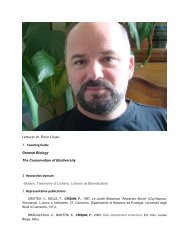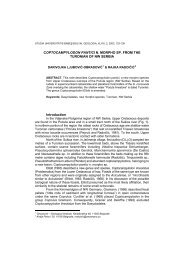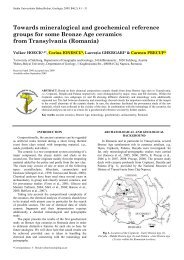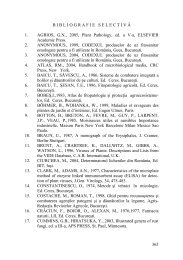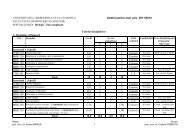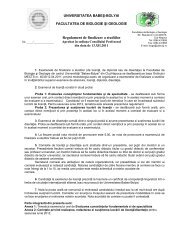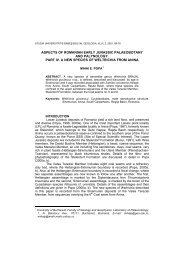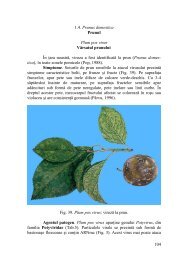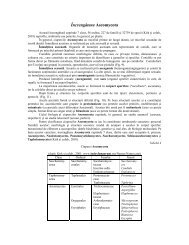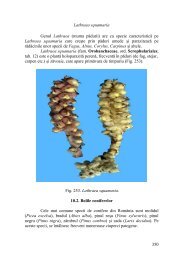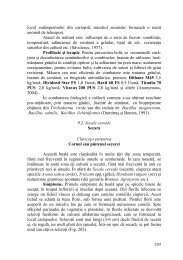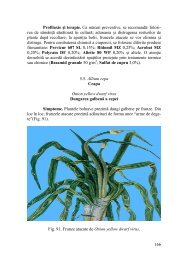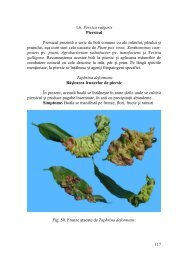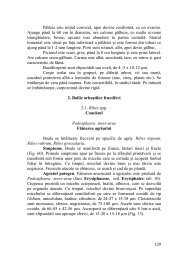paleoenvironmental setting of rudists in the upper cretaceous
paleoenvironmental setting of rudists in the upper cretaceous
paleoenvironmental setting of rudists in the upper cretaceous
Create successful ePaper yourself
Turn your PDF publications into a flip-book with our unique Google optimized e-Paper software.
Fig. 4. Rudist assemblage: a –Adapical view <strong>of</strong> RV <strong>of</strong> Vacc<strong>in</strong>ites sulcatus DEFRANCE (S.626); b – abapical<br />
view <strong>of</strong> RV <strong>of</strong> Vacc<strong>in</strong>ites sulcatus DEFRANCE (S.527); c – abapical view <strong>of</strong> RV <strong>of</strong> Vacc<strong>in</strong>ites sulcatus<br />
DEFRANCE (S.592a) and Hippurites aff. nabres<strong>in</strong>ensis FUTTERER (S.592b); d –abapical view <strong>of</strong> RV <strong>of</strong> Vacc<strong>in</strong>ites<br />
gosaviensis DOUVILLÉ (S.601a) and Vacc<strong>in</strong>ites sulcatus DEFRANCE (S.601b); e – abapical view <strong>of</strong><br />
RV <strong>of</strong> Miseia Fig. 3. pajaudi Macr<strong>of</strong>acies PATRULIUS; <strong>of</strong> carbonate f – transversal rocks: a-d – section bioconstructions <strong>of</strong> LV <strong>of</strong> Mitrocapr<strong>in</strong>a with <strong>rudists</strong> (a-b sp.; – g predom<strong>in</strong>antly<br />
– adapical view <strong>of</strong> RV<br />
<strong>of</strong> Gorjanovicia Vacc<strong>in</strong>ites sp. sulcatus (S.648); and h - Vacc<strong>in</strong>ites abapical view gosaviensis; <strong>of</strong> RV c <strong>of</strong> – Lapeirousia Vacc<strong>in</strong>ites sp. sp.(S.619); and Hippurites k - adapical nabres<strong>in</strong>ensis; view <strong>of</strong> RV <strong>of</strong><br />
Miseia sp. d – (S.539); Vacc<strong>in</strong>ites i – sp. abapical and large view plagioptychids); <strong>of</strong> RV <strong>of</strong> Gorjanovicia e – bioaccumulations costata POLSAK with radiolitids; (S.707); j – f-g Facies – silici- with radiolitids<br />
(R), clastic Plagioptychus deposits represented sp. (P) and by fragments conglomerates, <strong>of</strong> coral microconglomerates (C) (S.588); l –abapical and bioclastic view <strong>of</strong> RV sandstones, <strong>of</strong> Praeradiolites<br />
subtoucasi erosionally TOUCAS overlaid. (S.598).<br />
Concern<strong>in</strong>g <strong>the</strong> composition <strong>of</strong> <strong>the</strong> radiolitids assemblage,<br />
one can po<strong>in</strong>t out <strong>the</strong> wide diversity <strong>of</strong><br />
species, typical for both <strong>the</strong> Gosau facies but also<br />
for <strong>the</strong> south-European, Mediterranean prov<strong>in</strong>ce:<br />
Miseia (Turkey-Karacabey-Öztemür, 1979; Özer,<br />
104<br />
1992), Gorjanovicia (Turkey-Özer, 1982), Mitrocapr<strong>in</strong>a<br />
(Bulgaria–Tzankov, 1965; Turkey-Özer<br />
and Fenerci, 1993; Greece – Steuber, 1999). These<br />
species are now first mentioned from <strong>the</strong> Upper<br />
Cretaceous deposits cropp<strong>in</strong>g out <strong>in</strong> <strong>the</strong> study area.



